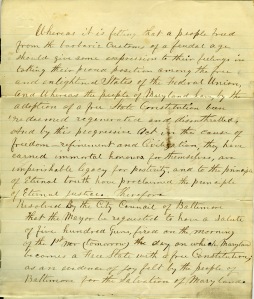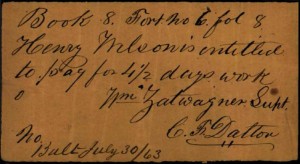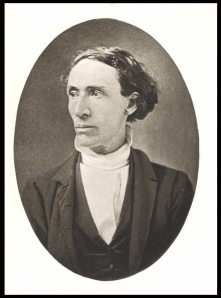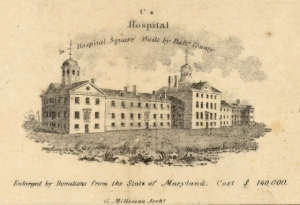 Report… Ladies’ Southern Relief Association, 1866 (Rarebooks Collection, Special Collections, University of Maryland Libraries)
The Civil War deeply divided Baltimoreans along philosophical and sectional lines. The Secessionist women of Baltimore, those whose sympathies lay with the South, were often singled out for their devotion to the Confederacy. They supported their husbands and brothers in gray throughout the war, often risking arrest, imprisonment, or banishment. During the post-war era, the 1866 Southern Relief Fair provided the large-scale opportunity for them to demonstrate both their patriotic and benevolent dedication to the people of the South.
Fundraising fairs in Baltimore had been organized and held for decades previously. Most Baltimore fairs, but not all, appear to have been orchestrated by women to benefit their own church congregations. One of the earliest recorded, held in 1827, was to aid the needy children of Greece in the aftermath of the overthrow of their Turkish occupiers. The largest such effort came in 1864, with the Maryland State Fair for U.S. Soldier Relief or, as it is more commonly known, the Baltimore Sanitary Fair.
The prospect of holding a fair to raise funds for impoverished Southerners first arose in Baltimore during the fall of 1865. The sixty-six year old Jane Gilmore Howard, wife of General Benjamin Chew Howard, was elected to serve as the President of the Relief Fair. All six of Mrs. Howard’s sons had worn the Confederate gray. Annie Thomas, 46, a Virginian by birth, and Elizabeth Key Howard, 62, the daughter of Francis Scott Key, served as vice presidents. These latter two women were distinguished from the other Fair executive committee members in that their spouses had been arrested in 1861 and detained by US military authorities for disloyalty.
By early March 1866, 316 women had banded together to shape and promote the relief fair. A handful of well-to-do German immigrant women were also included. It does not appear that any woman officer connected with Baltimore’s 1864 US Sanitary Fair served as a manager in this endeavor. Speaking of the Relief Fair committee, the Baltimore American newspaper stated “[w]e do not find the name of a single loyal lady, nor among its gentleman managers and… we find… that the great mass… have been, and still are, active and persistent in the sentiment of disloyalty.”
In contrast to the 1864 Sanitary Fair, the April 2, 1866 opening day of the Relief Fair did not bring a holiday-like atmosphere throughout the city. No parades; businesses and schools remained open. Held at the Maryland Institute hall (when it was located near today’s Inner Harbor), the Relief Fair hosted no high ranking Washington officials on the opening night or any night. Also noticeably absent was any official delegation from Baltimore City or the Maryland State government.
The city newspapers reported immense crowds present throughout the entire length of the fair’s run. As the Baltimore Gazette reported, “[s]tretched across the centre of the hall is the star-spangled banner [a US flag], and at the end of the hall, the same emblems are [draped].” This overt nod to national patriotism and to a restored Union, however, was tempered by what no city newspaper described explicitly. Upon many of the 57 display tables, either for sale or for raffle, could be found portraits of the military heroes of the Confederacy. Paintings, prints and photographs of Robert E. Lee, Stonewall Jackson, Joseph E. Johnston, to name a few, could be found throughout the hall. No likenesses of Jefferson Davis appear to have been present. Less than one year before, Baltimore’s Secessionists could have been arrested by the US Provost Marshall for displaying or even possessing such images.
The Southern Relief Fair could be termed a great success when compared to similar efforts. The 1864 Sanitary Fair managers raised a final amount of just over $86,000. The Relief Fair women, in comparison, grossed approximately $160,000 for their efforts, about 2.3 million dollars in 2011 currency. The Baltimore Gazette opined “[the ladies] have been constant in their attendance and unwearied in their attentions…[t]he Fair women of Baltimore have crowned themselves with laurels, well deserved in many ways. The Fair also revealed that the split in Baltimore society still remained chasm-like within the breasts of many. The Baltimore American, a moderate Unionist paper during the conflict, simply refused to report on the Relief Fair. It gave the following reason:
Report… Ladies’ Southern Relief Association, 1866 (Rarebooks Collection, Special Collections, University of Maryland Libraries)
The Civil War deeply divided Baltimoreans along philosophical and sectional lines. The Secessionist women of Baltimore, those whose sympathies lay with the South, were often singled out for their devotion to the Confederacy. They supported their husbands and brothers in gray throughout the war, often risking arrest, imprisonment, or banishment. During the post-war era, the 1866 Southern Relief Fair provided the large-scale opportunity for them to demonstrate both their patriotic and benevolent dedication to the people of the South.
Fundraising fairs in Baltimore had been organized and held for decades previously. Most Baltimore fairs, but not all, appear to have been orchestrated by women to benefit their own church congregations. One of the earliest recorded, held in 1827, was to aid the needy children of Greece in the aftermath of the overthrow of their Turkish occupiers. The largest such effort came in 1864, with the Maryland State Fair for U.S. Soldier Relief or, as it is more commonly known, the Baltimore Sanitary Fair.
The prospect of holding a fair to raise funds for impoverished Southerners first arose in Baltimore during the fall of 1865. The sixty-six year old Jane Gilmore Howard, wife of General Benjamin Chew Howard, was elected to serve as the President of the Relief Fair. All six of Mrs. Howard’s sons had worn the Confederate gray. Annie Thomas, 46, a Virginian by birth, and Elizabeth Key Howard, 62, the daughter of Francis Scott Key, served as vice presidents. These latter two women were distinguished from the other Fair executive committee members in that their spouses had been arrested in 1861 and detained by US military authorities for disloyalty.
By early March 1866, 316 women had banded together to shape and promote the relief fair. A handful of well-to-do German immigrant women were also included. It does not appear that any woman officer connected with Baltimore’s 1864 US Sanitary Fair served as a manager in this endeavor. Speaking of the Relief Fair committee, the Baltimore American newspaper stated “[w]e do not find the name of a single loyal lady, nor among its gentleman managers and… we find… that the great mass… have been, and still are, active and persistent in the sentiment of disloyalty.”
In contrast to the 1864 Sanitary Fair, the April 2, 1866 opening day of the Relief Fair did not bring a holiday-like atmosphere throughout the city. No parades; businesses and schools remained open. Held at the Maryland Institute hall (when it was located near today’s Inner Harbor), the Relief Fair hosted no high ranking Washington officials on the opening night or any night. Also noticeably absent was any official delegation from Baltimore City or the Maryland State government.
The city newspapers reported immense crowds present throughout the entire length of the fair’s run. As the Baltimore Gazette reported, “[s]tretched across the centre of the hall is the star-spangled banner [a US flag], and at the end of the hall, the same emblems are [draped].” This overt nod to national patriotism and to a restored Union, however, was tempered by what no city newspaper described explicitly. Upon many of the 57 display tables, either for sale or for raffle, could be found portraits of the military heroes of the Confederacy. Paintings, prints and photographs of Robert E. Lee, Stonewall Jackson, Joseph E. Johnston, to name a few, could be found throughout the hall. No likenesses of Jefferson Davis appear to have been present. Less than one year before, Baltimore’s Secessionists could have been arrested by the US Provost Marshall for displaying or even possessing such images.
The Southern Relief Fair could be termed a great success when compared to similar efforts. The 1864 Sanitary Fair managers raised a final amount of just over $86,000. The Relief Fair women, in comparison, grossed approximately $160,000 for their efforts, about 2.3 million dollars in 2011 currency. The Baltimore Gazette opined “[the ladies] have been constant in their attendance and unwearied in their attentions…[t]he Fair women of Baltimore have crowned themselves with laurels, well deserved in many ways. The Fair also revealed that the split in Baltimore society still remained chasm-like within the breasts of many. The Baltimore American, a moderate Unionist paper during the conflict, simply refused to report on the Relief Fair. It gave the following reason:
“If there had been any attempt made, or any desire evinced, to secure the participation of the Union people of the city or State in this Fair, it would have been promptly responded to by them and heartily seconded by the American. On the contrary, there has been a persistent effort to make [the fair] a grand disloyal demonstration.”
In conclusion, the Southern Relief Fair gave Baltimore’s Secessionist women their most spectacular means to express their devotion to the people of the South. Channeling their energies, the women successfully mobilized thousands of fellow Marylanders, as well as sympathetic out-of-state parties, behind the cause of assisting the destitute citizens of the former Confederacy.

Report… Ladies’ Southern Relief Association, 1866 (Rarebooks Collection, Special Collections, University of Maryland Libraries)
The Civil War deeply divided Baltimoreans along philosophical and sectional lines. The Secessionist women of Baltimore, those whose sympathies lay with the South, were often singled out for their devotion to the Confederacy. They supported their husbands and brothers in gray throughout the war, often risking arrest, imprisonment, or banishment. During the post-war era, the 1866 Southern Relief Fair provided the large-scale opportunity for them to demonstrate both their patriotic and benevolent dedication to the people of the South.
Fundraising fairs in Baltimore had been organized and held for decades previously. Most Baltimore fairs, but not all, appear to have been orchestrated by women to benefit their own church congregations. One of the earliest recorded, held in 1827, was to aid the needy children of Greece in the aftermath of the overthrow of their Turkish occupiers. The largest such effort came in 1864, with the Maryland State Fair for U.S. Soldier Relief or, as it is more commonly known, the Baltimore Sanitary Fair.
The prospect of holding a fair to raise funds for impoverished Southerners first arose in Baltimore during the fall of 1865. The sixty-six year old Jane Gilmore Howard, wife of General Benjamin Chew Howard, was elected to serve as the President of the Relief Fair. All six of Mrs. Howard’s sons had worn the Confederate gray. Annie Thomas, 46, a Virginian by birth, and Elizabeth Key Howard, 62, the daughter of Francis Scott Key, served as vice presidents. These latter two women were distinguished from the other Fair executive committee members in that their spouses had been arrested in 1861 and detained by US military authorities for disloyalty.
By early March 1866, 316 women had banded together to shape and promote the relief fair. A handful of well-to-do German immigrant women were also included. It does not appear that any woman officer connected with Baltimore’s 1864 US Sanitary Fair served as a manager in this endeavor. Speaking of the Relief Fair committee, the Baltimore American newspaper stated “[w]e do not find the name of a single loyal lady, nor among its gentleman managers and… we find… that the great mass… have been, and still are, active and persistent in the sentiment of disloyalty.”
In contrast to the 1864 Sanitary Fair, the April 2, 1866 opening day of the Relief Fair did not bring a holiday-like atmosphere throughout the city. No parades; businesses and schools remained open. Held at the Maryland Institute hall (when it was located near today’s Inner Harbor), the Relief Fair hosted no high ranking Washington officials on the opening night or any night. Also noticeably absent was any official delegation from Baltimore City or the Maryland State government.
The city newspapers reported immense crowds present throughout the entire length of the fair’s run. As the Baltimore Gazette reported, “[s]tretched across the centre of the hall is the star-spangled banner [a US flag], and at the end of the hall, the same emblems are [draped].” This overt nod to national patriotism and to a restored Union, however, was tempered by what no city newspaper described explicitly. Upon many of the 57 display tables, either for sale or for raffle, could be found portraits of the military heroes of the Confederacy. Paintings, prints and photographs of Robert E. Lee, Stonewall Jackson, Joseph E. Johnston, to name a few, could be found throughout the hall. No likenesses of Jefferson Davis appear to have been present. Less than one year before, Baltimore’s Secessionists could have been arrested by the US Provost Marshall for displaying or even possessing such images.
The Southern Relief Fair could be termed a great success when compared to similar efforts. The 1864 Sanitary Fair managers raised a final amount of just over $86,000. The Relief Fair women, in comparison, grossed approximately $160,000 for their efforts, about 2.3 million dollars in 2011 currency. The Baltimore Gazette opined “[the ladies] have been constant in their attendance and unwearied in their attentions…[t]he Fair women of Baltimore have crowned themselves with laurels, well deserved in many ways. The Fair also revealed that the split in Baltimore society still remained chasm-like within the breasts of many. The Baltimore American, a moderate Unionist paper during the conflict, simply refused to report on the Relief Fair. It gave the following reason:
“If there had been any attempt made, or any desire evinced, to secure the participation of the Union people of the city or State in this Fair, it would have been promptly responded to by them and heartily seconded by the American. On the contrary, there has been a persistent effort to make [the fair] a grand disloyal demonstration.”
In conclusion, the Southern Relief Fair gave Baltimore’s Secessionist women their most spectacular means to express their devotion to the people of the South. Channeling their energies, the women successfully mobilized thousands of fellow Marylanders, as well as sympathetic out-of-state parties, behind the cause of assisting the destitute citizens of the former Confederacy.











![Payroll Slip, [July 1863] BRG41-3-1497A](https://baltimorecityarchives.files.wordpress.com/2013/07/untitled-1.jpg?w=300&h=182)





